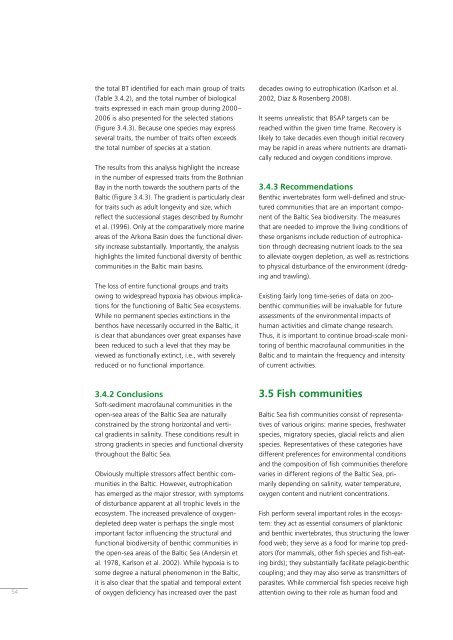BSEP116B Biodiversity in the Baltic Sea - Helcom
BSEP116B Biodiversity in the Baltic Sea - Helcom
BSEP116B Biodiversity in the Baltic Sea - Helcom
You also want an ePaper? Increase the reach of your titles
YUMPU automatically turns print PDFs into web optimized ePapers that Google loves.
<strong>the</strong> total BT identified for each ma<strong>in</strong> group of traits<br />
(Table 3.4.2), and <strong>the</strong> total number of biological<br />
traits expressed <strong>in</strong> each ma<strong>in</strong> group dur<strong>in</strong>g 2000–<br />
2006 is also presented for <strong>the</strong> selected stations<br />
(Figure 3.4.3). Because one species may express<br />
several traits, <strong>the</strong> number of traits often exceeds<br />
<strong>the</strong> total number of species at a station.<br />
The results from this analysis highlight <strong>the</strong> <strong>in</strong>crease<br />
<strong>in</strong> <strong>the</strong> number of expressed traits from <strong>the</strong> Bothnian<br />
Bay <strong>in</strong> <strong>the</strong> north towards <strong>the</strong> sou<strong>the</strong>rn parts of <strong>the</strong><br />
<strong>Baltic</strong> (Figure 3.4.3). The gradient is particularly clear<br />
for traits such as adult longevity and size, which<br />
reflect <strong>the</strong> successional stages described by Rumohr<br />
et al. (1996). Only at <strong>the</strong> comparatively more mar<strong>in</strong>e<br />
areas of <strong>the</strong> Arkona Bas<strong>in</strong> does <strong>the</strong> functional diversity<br />
<strong>in</strong>crease substantially. Importantly, <strong>the</strong> analysis<br />
highlights <strong>the</strong> limited functional diversity of benthic<br />
communities <strong>in</strong> <strong>the</strong> <strong>Baltic</strong> ma<strong>in</strong> bas<strong>in</strong>s.<br />
The loss of entire functional groups and traits<br />
ow<strong>in</strong>g to widespread hypoxia has obvious implications<br />
for <strong>the</strong> function<strong>in</strong>g of <strong>Baltic</strong> <strong>Sea</strong> ecosystems.<br />
While no permanent species ext<strong>in</strong>ctions <strong>in</strong> <strong>the</strong><br />
benthos have necessarily occurred <strong>in</strong> <strong>the</strong> <strong>Baltic</strong>, it<br />
is clear that abundances over great expanses have<br />
been reduced to such a level that <strong>the</strong>y may be<br />
viewed as functionally ext<strong>in</strong>ct, i.e., with severely<br />
reduced or no functional importance.<br />
decades ow<strong>in</strong>g to eutrophication (Karlson et al.<br />
2002, Diaz & Rosenberg 2008).<br />
It seems unrealistic that BSAP targets can be<br />
reached with<strong>in</strong> <strong>the</strong> given time frame. Recovery is<br />
likely to take decades even though <strong>in</strong>itial recovery<br />
may be rapid <strong>in</strong> areas where nutrients are dramatically<br />
reduced and oxygen conditions improve.<br />
3.4.3 Recommendations<br />
Benthic <strong>in</strong>vertebrates form well-def<strong>in</strong>ed and structured<br />
communities that are an important component<br />
of <strong>the</strong> <strong>Baltic</strong> <strong>Sea</strong> biodiversity. The measures<br />
that are needed to improve <strong>the</strong> liv<strong>in</strong>g conditions of<br />
<strong>the</strong>se organisms <strong>in</strong>clude reduction of eutrophication<br />
through decreas<strong>in</strong>g nutrient loads to <strong>the</strong> sea<br />
to alleviate oxygen depletion, as well as restrictions<br />
to physical disturbance of <strong>the</strong> environment (dredg<strong>in</strong>g<br />
and trawl<strong>in</strong>g).<br />
Exist<strong>in</strong>g fairly long time-series of data on zoobenthic<br />
communities will be <strong>in</strong>valuable for future<br />
assessments of <strong>the</strong> environmental impacts of<br />
human activities and climate change research.<br />
Thus, it is important to cont<strong>in</strong>ue broad-scale monitor<strong>in</strong>g<br />
of benthic macrofaunal communities <strong>in</strong> <strong>the</strong><br />
<strong>Baltic</strong> and to ma<strong>in</strong>ta<strong>in</strong> <strong>the</strong> frequency and <strong>in</strong>tensity<br />
of current activities.<br />
54<br />
3.4.2 Conclusions<br />
Soft-sediment macrofaunal communities <strong>in</strong> <strong>the</strong><br />
open-sea areas of <strong>the</strong> <strong>Baltic</strong> <strong>Sea</strong> are naturally<br />
constra<strong>in</strong>ed by <strong>the</strong> strong horizontal and vertical<br />
gradients <strong>in</strong> sal<strong>in</strong>ity. These conditions result <strong>in</strong><br />
strong gradients <strong>in</strong> species and functional diversity<br />
throughout <strong>the</strong> <strong>Baltic</strong> <strong>Sea</strong>.<br />
Obviously multiple stressors affect benthic communities<br />
<strong>in</strong> <strong>the</strong> <strong>Baltic</strong>. However, eutrophication<br />
has emerged as <strong>the</strong> major stressor, with symptoms<br />
of disturbance apparent at all trophic levels <strong>in</strong> <strong>the</strong><br />
ecosystem. The <strong>in</strong>creased prevalence of oxygendepleted<br />
deep water is perhaps <strong>the</strong> s<strong>in</strong>gle most<br />
important factor <strong>in</strong>fluenc<strong>in</strong>g <strong>the</strong> structural and<br />
functional biodiversity of benthic communities <strong>in</strong><br />
<strong>the</strong> open-sea areas of <strong>the</strong> <strong>Baltic</strong> <strong>Sea</strong> (Anders<strong>in</strong> et<br />
al. 1978, Karlson et al. 2002). While hypoxia is to<br />
some degree a natural phenomenon <strong>in</strong> <strong>the</strong> <strong>Baltic</strong>,<br />
it is also clear that <strong>the</strong> spatial and temporal extent<br />
of oxygen deficiency has <strong>in</strong>creased over <strong>the</strong> past<br />
3.5 Fish communities<br />
<strong>Baltic</strong> <strong>Sea</strong> fish communities consist of representatives<br />
of various orig<strong>in</strong>s: mar<strong>in</strong>e species, freshwater<br />
species, migratory species, glacial relicts and alien<br />
species. Representatives of <strong>the</strong>se categories have<br />
different preferences for environmental conditions<br />
and <strong>the</strong> composition of fish communities <strong>the</strong>refore<br />
varies <strong>in</strong> different regions of <strong>the</strong> <strong>Baltic</strong> <strong>Sea</strong>, primarily<br />
depend<strong>in</strong>g on sal<strong>in</strong>ity, water temperature,<br />
oxygen content and nutrient concentrations.<br />
Fish perform several important roles <strong>in</strong> <strong>the</strong> ecosystem:<br />
<strong>the</strong>y act as essential consumers of planktonic<br />
and benthic <strong>in</strong>vertebrates, thus structur<strong>in</strong>g <strong>the</strong> lower<br />
food web; <strong>the</strong>y serve as a food for mar<strong>in</strong>e top predators<br />
(for mammals, o<strong>the</strong>r fish species and fish-eat<strong>in</strong>g<br />
birds); <strong>the</strong>y substantially facilitate pelagic-benthic<br />
coupl<strong>in</strong>g; and <strong>the</strong>y may also serve as transmitters of<br />
parasites. While commercial fish species receive high<br />
attention ow<strong>in</strong>g to <strong>the</strong>ir role as human food and

















